A PEAR, 170 YEARS LATER
/10 Comments/in Fruit, Gardening/by Lee ReichA Luscious Fruit in Winter
All fruits did well this past season but it was especially a banner year for pears. Why do I mention this now? Because we’re still eating them and they are delicious. “Them” is actually just one variety — Passe Crassane, not a variety you’d find on a supermarket shelf, but which is available as a tree.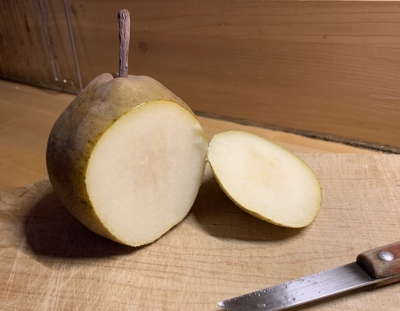
Timely harvest, storage, and ripening of pears melds art and science; since this was my first crop from Passe Crassane, I was wary as I sliced off a taste. It was like slicing through butter, a good omen. The flesh was “white, fine. melting, [sugary], perfumed, and agreeably sprightly,” to quote from The Pears of New York, U. P. Hedrick’s 1921 classic. Delicious.
The seed for this pear was sown, literally, by one Louis Boisbunel in Rouen, France in 1845. Ten years later, the tree showed its worth and the fruit made its debut. Passe Crassane is a winter pear that needs to be harvested mature — here, in early November — and then kept in cold storage for a couple of months to ripen to full flavor. Under ideal storage conditions, fruits keep well for months.
This variety was very popular in its century of origin, and its cultivation spread to Italy, Spain, Germany, and England. Commercially, stems were dipped in a red wax to prevent water loss during storage; those red-tipped stems became a signature of Passe Crassane. By the 20th century, Passe Crassane had fallen out of favor because of its susceptibility to diseases, including dreaded fireblight.
(My tree was struck by what I thought might be fireblight a year and a half ago, so I had drastically lopped it back well below what might have been blighted portions, planning to graft the stump to another variety. Fortunately, one older branch remained below the lopping and that branch, for the first time this past season, bore fruit, heavily. I’ll let the tree re-develop from one of the few watersprouts that shot skyward where the tree was lopped.)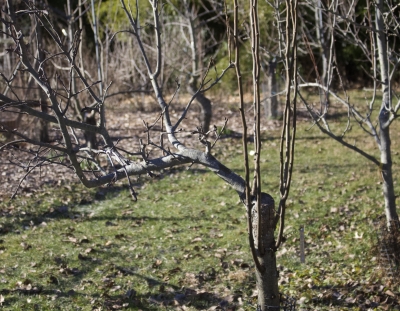
The Hard Part of Growing Pears
Apple, cherry, and other common tree fruits are usually beset with pest problems that make them hard to grow. Not so for pears. The hard part about growing pears is knowing when to harvest them and then ripening them to perfection.
Yeh, yeh, I’ve read all about various indicators that show pears are ready for harvest: 1) When the fruit stalk separates easily from the stem as you lift and twist; 2) When the skin color lightens slightly; 3) When the small lenticels on the skin turn from white to brown; 4) When the first fruits start to drop. And, my favorite, recording the harvest date, once you get it right, and then harvesting on about that date every year.

Picking Seckel pear
No matter what the method, a pear should be firm, not at all soft, once ready for harvest. Pears ripen from the inside out. So fruit left on tree to thoroughly ripen is mostly brown mush on the inside by then.
All those indicators notwithstanding, I am much better at timely harvesting of pear varieties I’ve grown and harvested for a number of years.
So much for harvest; now for storage. On or near freezing is ideal. Cold temperatures slow ripening, and, for all except very early varieties, primes the fruit to begin ripening.
Ethylene, a natural, gaseous plant hormone can unduly speed ripening. Mature pears give off very little ethylene; not so for harvested apples and many other fruits, so keep these other fruits away from the pears unless a whole lot of pears are needed ready for eating soon. (I cover ethylene more thoroughly in my book The Ever Curious Gardener: Using a Little Natural Science for a Much Better Garden.)
Finally, on to ripening, which occurs as fruits are brought into warmth, ideally a cool room, 60-70 degrees F. I press a finger against the stem end of the fruit, and if there is any give at all, the fruit is ready for eating.
All this finickiness with harvest, storage, and ripening is unnecessary with Asian pears, which are different species from European pears. Let Asian varieties ripen thoroughly on the tree, meaning they remove easily with a lift and twist, and are fully colored. Then eat. Or keep them refrigerated, and get them out to eat whenever you’re so inclined.

Asian pear, Korean Giant
WILL THE TRUE BALSAM PLEASE STAND UP?
/8 Comments/in Design/by Lee ReichCold Enough for Balsam Fir?
Ah, to sit by the fire on a cold winter’s eve. The fire’s warmth suffuses me with somnolence and drives into the air a resinous, woodsy aroma from my fresh cut balsam fir branches draped about the room or steaming on the woodstove.
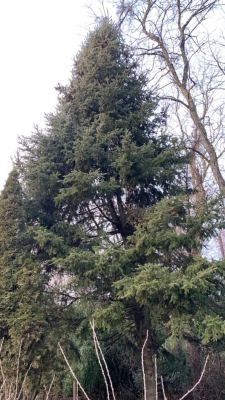
Balsam fir (Abies balsamea) would be an oddity amongst my plants. Here in the colder part of Zone 5, blackberries and some of my grapes have been pushed to their northern limits. Balsam fir would be unique in being a plant pushed to its southern limit. Most of my plants require well-drained soils. Balsam fir grows in well-drained soil, but it also will grow in swampy land, even very acidic (pH 5.0-6.0), swampy land
Balsam fir is native from northern New England to the tundra and mountaintops further south. I live in lowland. In those cold, moist locales where they are native, the trees grow slowly to become dense, pyramidal spires 50 feet tall with dark, shiny green, flattened needles. (Flattened needles are one way to distinguish firs from spruces, Picea species, which have rounded needles.)
Long ago I realized that it might be just too hot here in summer to grow balsam fir. Numerous books that I consulted warned about the futility of trying to grow balsam fir where it’s not native. Excessive heat would cause the needles to fall prematurely, leaving the tree, after a few decades, thinned out and unkempt. The prognosis for successful growing of balsam fir here seemed slim.
Looking Elsewhere for Balsam
So I looked into getting my balsamy aromas elsewhere. Many plants yield “true” balsam, an aroma based on resins or oleoresins containing benzoic acid, cinnamic acid, or both. It’s too cold here, though, to grow most plants with this true balsam aroma: Balsam of Peru and Balsam of Tolu, from Myroxylon pereirae and M. balsamum, respectively, both trees of Central America; and liquid storax, a balsam from Liquidambar orientalis, a tree of Asia Minor, or from the Javanese plant Altingia excelsa.
One plant that is hardy here and does yield true balsam is sweetgum (Liquidambar styraciflua), which yields a balsam known as liquidambar, or copal, balsam. One problem with sweetgum is that it’s not an evergreen, so would not fill the bill for aromatic, winter greenery. A very pretty tree, though.

Sweetgum leaves & gumballs
I emphasized “true” balsam above because there are other balsams that are something less than “true,” which means they lack both benzoic and cinnamic acids. Balsam fir, whose balsam goes under the names of Canada balsam or Canada turpentine, does not yield a true balsam. Two other less-than-true balsams are Balm of Gilead (Mecca balsam), from the Middle Eastern plant Commiphora opobalsamum, and Gurjun balsam, from Indian species of Dipterocarpus. Here, cold would snuff out the life of either of these two plants.
The question of winter survival is a moot point for annual plants, and there are two annuals with “balsam” in their name. One of these is garden balsam, Impatiens balsamina, a relative of impatiens. I’ve occasionally grown this very pretty, old-fashioned annual, but don’t recall any woody, resinous odor.

Garden balsam
Another balsam is balsam apple, Momordia balsamina, a vining cucumber relative which produces gherkin-shaped, yellowish red “apples.” I’ve never grown balsam apple, but doubt it has the desired aroma. None of its relatives that I have met — winter squashes, summer squashes, gourds, pumpkins, and luffas — have any odor of balsam.
I Give Balsam Fir a Try Anyway
So where did this leave me for my balsamy winter greenery? Eighty years ago I could have just gone out and bought a Christmas tree. Balsam fir was the most popular Christmas tree until the 1930s. Then, its general popularity was superseded by Scotch pine, which grows faster and holds its needles better.
Almost 30 years ago, the poor prognosis notwithstanding, I went ahead and planted a few foot-high balsam fir seedlings in a partly shaded rear portion of my yard. The soil there is rich and perfectly drained.

My 30-year-old balsam fir
Trees took well to their new home. Unfortunately, our puppy Stick liked to play with the trees, not to their benefit. Fortunately, one tree escaped his antics. That tree is still alive, actually more than alive. I can cut all the aromatic branches I want from this robust, now 36.4 foot high tree!
THERE ARE LOTS OF NUTS OUT THERE
/10 Comments/in Gardening/by Lee ReichI’ve written recently about how bountiful this past season has been with fruits. Well, botanically, at least, “fruits” includes “nuts.” More on this later.* The nut harvest was also abundant.
Except for last year, just about every year has been a good year for black walnuts. But this year, it didn’t take long to pick up and fill baskets quickly. After being husked, cleaned, and then left to cure in a squirrel-proof loft, I’ve started cracking them (with my ‘Master Nutcracker’). Large, plum, tasty nutmeats drop free from the shells.
A Surprise Nut
What surprised me most was the harvest of English walnuts, botanically Juglans regia and also known as Persian walnuts. (The moniker “English” may be because of the significant role played by English sailors in distributing the nuts around the world.) Persia, or Eastern Europe is where this plant originated. Early on, humans introduced it to other parts of the world, including England, where Romans brought them 2,000 years ago. In the seventeenth century, the nuts and the wood of these trees was held in such high esteem in parts of Europe that a certificate of having planted a certain number of trees was needed before a man was allowed to marry.
Walnuts arrived in my garden in 2006, from seed from cold-hardy trees handed out at the Saratoga, New York meeting of the New York Nut Growers Association. I planted six of the walnut seeds. Because I have limited space and did not have high hopes for success, I arranged them in two stations of three plants each, with about 30 feet between the stations. In contrast to plants propagated asexually, such as by grafting or cuttings, plants grown from seed have some genetic diversity, in the same way you and your siblings are diverse from each other. I figured that eventually I would remove all but the one best tree at each station.
Despite the threat of frost killing blossoms in spring, walnut blight, defoliation by anthracnose disease in summer, and squirrels robbing all the nuts in fall, I was able to harvest plenty. Earlier in the season, I did notice that not all trees were bearing, or bearing well, so I cut down two of the slackers, one from each station.
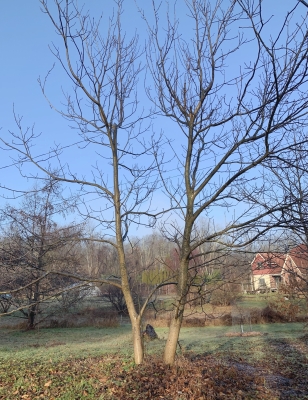
English walnut trees, 15 years ol
As far as differences in the nuts from tree to tree, it’s hard to say for sure at this point except to say the nuts on one of the trees may have been smaller. I’ll take a more quantitative look next year.
Walnut trees are known to be slow to come into bearing. There’s a Flanders folk saying that goes, “By the time the tree is big, the planter surely will be dead.” Well, I planted the trees from seed, they have borne and grown fairly big, and I’m not dead.
Still Waiting
Two nut trees whose first fruits I’m eagerly awaiting are both shellbark hickories (Carya laciniosa). Shagbark hickory (C. ovata) is very common around here and throughout eastern U.S., and is notable for its — duh! — very shaggy bark and tasty but small and hard to crack nuts. 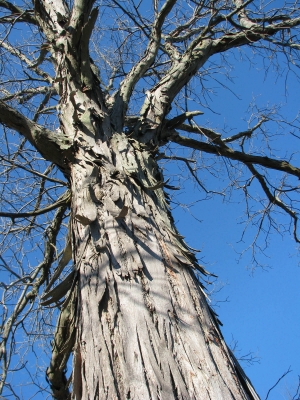 Shellbark hickory’s native range doesn’t extend as far east and south as shagbark’s. It’s found mostly along the Ohio and Mississippi Rivers, and bordering regions; nowhere, though, is it common. Also, the bark is less shaggy. The clincher is that shellbark nuts are much larger, around two inches long, and with thinner shells, so you get more bang for your buck with each nut you crack.
Shellbark hickory’s native range doesn’t extend as far east and south as shagbark’s. It’s found mostly along the Ohio and Mississippi Rivers, and bordering regions; nowhere, though, is it common. Also, the bark is less shaggy. The clincher is that shellbark nuts are much larger, around two inches long, and with thinner shells, so you get more bang for your buck with each nut you crack.
I planted the varieties Simpson and Grainger, both of which were selected for easy shelling. (Nut alert! I have since learned that Grainger is, in fact, a shagbark hickory, albeit a variety selected for large shells that crack out well.)
But how about some nuts! Simpson was planted in 2014 and Grainger in 2015, and both grow very slowly, about twelve inches per year. Bearing age is reputedly only a few years with a grafted trees, which, being named varieties, both were.
Nuts or no nuts, the trees are beautiful, their leaves turning a rich, golden yellow in autumn and, in winter, the stout branches punctuated and capped by fat buds.
Botanical Nuts, and Not
*Back to fruits: A fruit, botanically, is any seed-bearing structure of a flowering plant formed from a ripened ovary along with seeds and other structures. A nut is a kind of fruit, in this case with a kernel surrounded by a hard nutshell. A nut’s shell does not open to release the kernel. So all nuts are fruits but all fruits aren’t nuts. Botanically speaking.
Some fruits commonly called nuts, such as almond, pistachio, Brazil nut, walnut, pecan, and macadamia, are not true nuts; they are dry drupes (which doesn’t sound very complimentary, does it?). A nut is a dry drupe whose kernel is enclosed within a stony pit surrounded by flesh and a skin. Think of a peach. That’s a (non)dry drupe.
Chestnut, hazelnut, oak, and birch are examples of true nuts.
That’s all botany. Out on the street, we call lots of things nuts. Peanuts, for example, which are actually legumes, just like peas and beans.

